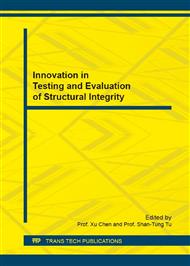p.173
p.178
p.187
p.192
p.197
p.204
p.209
p.216
p.221
Study on the Non-Probabilistic Interval Damage of High Temperature Furnace Tube
Abstract:
Uncertainty of parameters like material mechanical properties are traditionally described by probabilistic model, which requires detailed statistical information of parameters limited to obtain in engineering application. In this paper, the problem is solved by using the non-probabilistic convex model that only needs the upper and lower bounds of variables instead of abundant statistical information, which greatly reduces the demand of data and avoids unsafe results caused by the scatter of data. Based on the non-probabilistic convex model, the non-probabilistic interval analysis method is introduced to calculate the creep damage of HK40 high temperature furnace tube and to discuss the influence of operation conditions on creep damage with operation pressure and operation temperature regarded as interval variables. Consequently, the effect of outer wall temperature on creep damage interval is greater at the beginning of furnace tube operation stage. With the increase of running time, the effect of inner wall temperature on creep damage interval is greater and greater, and at the same time greater than that of creep damage interval when the outer wall temperature considered as interval variables. When the operating pressure is treated as interval variable, the upper and lower bounds of creep damage are nearly in a straight line that indicates the effect of pressure change on damage is little. Meanwhile, the life of high temperature furnace tube is predicted according to the definition of non-probabilistic interval index, and the analysis results are compared with the results of probabilistic model. The analysis results sufficiently demonstrate that the non-probabilistic approach presented in this paper is viable.
Info:
Periodical:
Pages:
197-203
Citation:
Online since:
September 2016
Authors:
Price:
Сopyright:
© 2017 Trans Tech Publications Ltd. All Rights Reserved
Share:
Citation:


